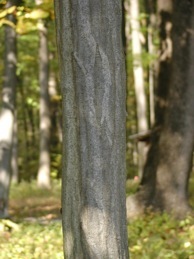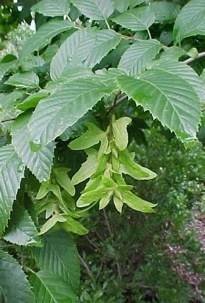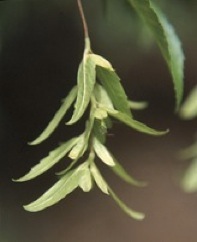Carpinus caroliniana: Musclewood
British author Ray Mears must have been thinking of the Hornbeam when he said a forager mustn’t pass up food no matter how meager.
Not all of the wild edibles can produce the best-tasting and most plentiful foods, but many can make their small contribution. And so it is with the American Hornbeam, Carpinus caroliniana, (kar-PYE-nus kair-oh-lin-ee-AY-nuh.)
Where I grew up it was called Ironwood or Hornbeam (which means hard tree.) Here in the South you’ll hear it called Blue Beech or Water Beech. While it is not a beech per se, its leaves — which turn orange red in the fall — can remind one of a beech as can its bark. But the hornbeam has its own special look, and it is of a well-muscled, sinewy tree.
Hornbeam looks taut, cut and buff, as if it goes to the forest gym twice a day and lifts … iron. Hence its other common name: Musclewood. Once you have the look of a Hornbeam inside your head you will always recognize it easily.
Hornbeam never grows to a huge size, perhaps six or seven inches through on average. But, it is strong and dense, 45 pounds per cubic foot. It’s been used for tool handles and support poles and
as well as bowls and dishes because it does not crack or split or have any flavor. It used to be favored to make charcoal powder.
Related to the Alders, Birches, Filberts, and Hophornbeams, the edible part are small nutlets,
though the bark does have some medicinal uses and the leaves have been employed as an astringent. There are some 33,000 seeds to a pound, though every three to five years the tree will produce larger crops than usual. A heavily seeding tree is between 25 and 50 years old. As fare goes, the nutlets are neither great nor awful, but they are small, which is why they are diminished by most writers. They can be eaten raw or roasted. Ray Mears also reports the sprouts are edible.
As for its scientific name, Caroliniana (like Virginiana) means North America, or at least central North America. Carpinus is the classical Latin name for the Hornbeam, and comes from “carpentum” a Roman horse-drawn vehicle with hard-wood wheels.
The Hornbeam grows throughout eastern North American, from Florida to Quebec, Louisiana north to Ontario It is also found in Texas, Arkansas, central and southern Mexico, Guatemala,
and western Honduras. In timberland the Hornbeam is considered a tough weed because it is too small for commercial use. However, it makes a good firewood.
Seeds of the Hornbeam are an important food for squirrels. Seeds, buds, and or catkins are consumed by many birds: Ruffed grouse, ring-necked pheasants, bobwhite, turkey, ducks and warblers. The fox will eat the seeds as well. Leaves, twigs, and larger stems are eaten by cottontails, beaver, and white-tailed deer. Deer will eat the shoots but it is not a preferred food. The Hornbeam, however, is heavily used by beaver because it is common their habitat. It is also the larval host of several butterflies including the Eastern Tiger Swallowtail, Striped hairstreak, Red-spotted Purple, and Tiger Swallow-tail.
Green Deane’s “Itemized” Plant Profile
IDENTIFICATION: A small tree, nearly shrubby, to 25 feet,rounded crown, twisted trunk. Leaves alternate, simple, elliptical to oval, 3 to 5 inches long, smaller on younger trees, pinnately veined, tip tapers to a sharp point, long and short teeth on leaves, smooth green above, paler below. Seeds, small, quarter to one third inch, ribbed nutlet on a 3-lobed, slightly folded leafy bract (resembles a maple seed), clustered on a long hanging stalk.
TIME OF YEAR: Flowers March to May, nutlets late August to winter. Wind can disperse them up to 64 feet from the tree.
ENVIRONMENT: Moist areas of established forests, occasionally fields. Makes a nice small yard tree, slow growing.
METHOD OF PREPARATION: Nutlets raw or roasted, boiled or ground to add to other flours or food. Take the papery bracts and rub them between you hands to free the nutlets.





